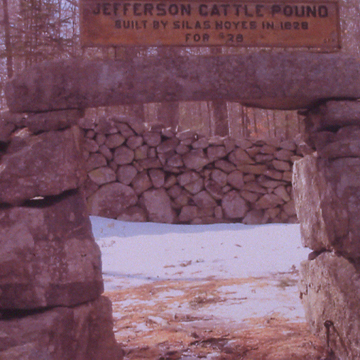The Jefferson Cattle Pound, a large stone structure built in 1829 to shelter and control stray cattle, offers a good example of how early-nineteenth-century Maine towns attempted to regulate an agricultural economy. Jefferson is a small town in Lincoln County located off Route 1, near Damariscotta Lake, in mid-coast Maine. The Cattle Pound is two miles southwest of the town of Jefferson.
Farmers have always struggled to control wandering livestock. Seventeenth-century colonists in southern New England grazed their cattle, sheep, and swine on commonly owned lands but these animals frequently found better fodder in neighboring gardens. Present-day Maine was then part of the District of Massachusetts, and although the Massachusetts Court ruled in 1635 that towns construct strong impoundments to control such wayfaring animals (the origin of the cattle pound), few Maine towns designated common pastures; instead settlers were expect to care for their own stock. With greater acreage required for pasturage, and fencing too expensive, cattle, sheep, and goats easily strayed from one pasture to another. To control such ranging or marauding, animal pounds, therefore, survived in Maine long after they were obsolete elsewhere. Licensed pound keepers often collected animals in their own barns, free of expense to the town, but in Jefferson residents voted in 1829 to build a town pound. At the suggestion of a committee consisting of Esquire Trask, Joseph Weeks, Justin Richardson, and John Murphy, the pound was built by local resident Silas Noyes “in a circular form . . . 40 foot diameter inside of the wall to be built of good Granet [ sic] Stone six foot thick at the bottom seven foot high with a good gate. . . .” The pound contains 190 tons of rock.
Following the recommendations of the report, the exterior face of the pound tapers toward the top and thus the width of the wall ranges from approximately four feet at the foundation to three feet at the top. The material consists of round to sub-rounded small boulders with larger stones set on ledge or in the ground. The enclosure has a single entrance located in the northeast sector facing Gardiner Road. The entrance is framed by three courses of transverse-laid, large granite boulders vaguely rectilinear in shape. The boulders form the sides of the approximately five-foot-wide doorway. A wooden gate was originally hung from eye-bolts driven into the western side wall; one of the the bolts still holds an original wrought-iron pintle. A large, rectangular granite lintel, eight feet long by one foot thick, spans the high entryway. Atop the lintel is a wooden sign reading “Jefferson Cattle Pound Built by Silas Noyes in 1828 for $28.”
Owned by the town, the Cattle Pound site is open to the visiting public.
References
Locke, William. “The Rise and Demise of the Cattle Pound, Harpswell and Maine.” Maine Historical Society Quarter33, no. 3-4 (Winter/Spring, 1993–1994): 210-221.
Mitchell, Christi A, “Jefferson Cattle Pound,” Lincoln County, Maine. National Register of Historic Places Inventory–Nomination Form, 2004. National Park Service, U.S. Department of Interior, Washington, D.C.














